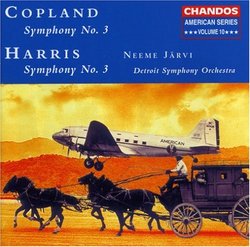| All Artists: Aaron Copland, Roy Harris, Neeme Järvi, Detroit Symphony Orchestra Title: Copland: Symphony No. 3; Harris: Symphony No. 3 Members Wishing: 0 Total Copies: 0 Label: Chandos Release Date: 9/24/1996 Genre: Classical Styles: Historical Periods, Modern, 20th, & 21st Century, Symphonies Number of Discs: 1 SwapaCD Credits: 1 UPC: 095115947425 |
Search - Aaron Copland, Roy Harris, Neeme Järvi :: Copland: Symphony No. 3; Harris: Symphony No. 3
 | Aaron Copland, Roy Harris, Neeme Järvi Copland: Symphony No. 3; Harris: Symphony No. 3 Genre: Classical
|
Larger Image |
CD Details |
CD ReviewsHarris and Copland Third Symphonies K. Farrington | Missegre, France | 02/25/2000 (5 out of 5 stars) "With an excellent coupling, Chandos provides us with first rate performances of two of the most succesful American symphonies. As a foreigner, Jaarvi knows how the folksy music should be played. For instance, in the Copland first movement the music starts quietly and swells in a huge arch to a big climax which in the concert hall should be nothing less than explosive. I went to see this work at San Diego Concert Hall some years ago and was disappointed at the current offerings on CD when I subsequently attempted to obtain my own definitive copy. However, this effect is captured here, the conductor resists the usual tendency to push the pace on, thus enabling the listener to pursue his thoughts in real time with Copland's exposition. The other movements are excellently played but to my mind it is the way the first movement is played which differentiates the performances of this work. The Harris work is a celebrated symphony which has always been played since it was penned in the 1930s. The mixture of New England hymnody and folk strains are totally synthesised into something new by Harris. It will be remembered that he was born in a log cabin, like our Abe! The opening is redolent of the hymn and yet the mood becomes transfigured as the symphony takes its course through stages entitled: Lyric; Tragic; Pastoral, etc. The conductor and orchestra do a wonderful job in playing this well known and well played symphony in a way that sounds fresh and exciting. The first performance must have been really special. This new music must have been like a breath of fresh air to the listeners. Harris has sublimated the sources of inspiration that made him a composer and yet kept pure those elements that move anyone who cares about or loves the Spirit of America. The work has a classisism about it, a restraint that is not so apparent in the more sprawling Copland. Thus two faces of America are portrayed here, firstly there is the Apollonian Harris, tethered to formal structure and outcome, his orchestra is not Wagnerian; he relies on form and structure rather than texture and volume. While the Copland may not be quite Dionysian, he does let rip in the finale (Fanfare for the Common Man) with an indulgence in emotional patriotism. One is aware this is a big symphonic ensemble playing. It is enough to make the hairs on the back of your neck stand on end!" The sound of America Alejandra Vernon | Long Beach, California | 01/03/2005 (5 out of 5 stars) "The sound of America's vast plains and the energy of its people are reflected in Copland and Harris compositions, and they always remind me of driving for miles and miles and seeing nothing but wheat fields and sky, and are also reminiscent of the small rural towns with earnest, hard-working people that one finds from coast to coast. How this feeling can be translated into notes of music is a mystery, but both composers mastered it, and Copland's music in particular; hearing a few notes from any of his pieces is hearing pure Americana. Roy Harris (1898-1979) premiered his Third Symphony in 1939, and it is by far his most famous piece, as well as one of the greatest symphonic works from an American composer. Its movements segue into each other, and it has a strong theme that punches its way into one's memory, and stays there for a lifetime. Aaron Copland (1900-1990) premiered his Third Symphony in 1946, and is here coupled well with the Harris Third. They are both equally strong, though the much shorter Harris work might have the edge on "greatness", and also on being the more memorable of the two. Estonian conductor Neeme Jarvi leads the Detroit Symphony with passion, marvelous in the gentle passages as well as the many vigorous ones. The recording was made at Detroit Symphony Orchestra Hall in October of 1996, and the sound is excellent. Total playing time is 57'25. " A Musical and Sonic Spectacular Craig Dorval | San Diego, CA USA | 03/27/2002 (5 out of 5 stars) "The subtlety, dynamics and frequency range of the Copland are stunning. This is an extraordinarily rare combination of the very best sonics with the very best performance. The Chandos producers and engineers have captured one of the most-moving symphonies of the last century in all its emotional depth and complexity. For the uninitiated, the Harris is more challenging, but it makes a good pairing. As someone who has listened to and programmed classical music for 30 years, I HIGHLY recommend this CD."
|

 Track Listings (9) - Disc #1
Track Listings (9) - Disc #1